SLVS613D October 2005 – December 2015 TPS65021
PRODUCTION DATA.
- 1 Features
- 2 Applications
- 3 Description
- 4 Revision History
- 5 Description (continued)
- 6 Pin Configuration and Functions
-
7 Specifications
- 7.1 Absolute Maximum Ratings
- 7.2 ESD Ratings
- 7.3 Recommended Operating Conditions
- 7.4 Thermal Information
- 7.5 Electrical Characteristics
- 7.6 Electrical Characteristics: Supply Pins VCC, VINDCDC1, VINDCDC2, VINDCDC3
- 7.7 Electrical Characteristics: Supply Pins VBACKUP, VSYSIN, VRTC, VINLDO
- 7.8 Electrical Characteristics: VDCDC1 Step-Down Converter
- 7.9 Electrical Characteristics: VDCDC2 Step-Down Converter
- 7.10 Electrical Characteristics: VDCDC3 Step-Down Converter
- 7.11 Timing Requirements
- 7.12 Typical Characteristics
-
8 Detailed Description
- 8.1 Overview
- 8.2 Functional Block Diagram
- 8.3
Feature Description
- 8.3.1 VRTC Output and Operation With or Without Backup Battery
- 8.3.2 Step-Down Converters, VDCDC1, VDCDC2, and VDCDC3
- 8.3.3 Power Save Mode Operation
- 8.3.4 Low-Ripple Mode
- 8.3.5 Soft-Start
- 8.3.6 100% Duty Cycle Low-Dropout Operation
- 8.3.7 Active Discharge When Disabled
- 8.3.8 Power-Good Monitoring
- 8.3.9 Low-Dropout Voltage Regulators
- 8.3.10 Undervoltage Lockout
- 8.3.11 Power-Up Sequencing
- 8.4 Device Functional Modes
- 8.5 Programming
- 8.6
Register Maps
- 8.6.1 VERSION Register Address: 00h (Read Only)
- 8.6.2 PGOODZ Register Address: 01h (Read Only)
- 8.6.3 MASK Register Address: 02h (Read and Write), Default Value: C0h
- 8.6.4 REG_CTRL Register Address: 03h (Read and Write), Default Value: FFh
- 8.6.5 CON_CTRL Register Address: 04h (Read and Write), Default Value: B1h
- 8.6.6 CON_CTRL2 Register Address: 05h (Read and Write), Default Value: 40h
- 8.6.7 DEFCORE Register Address: 06h (Read and Write), Default Value: 14h/1Eh
- 8.6.8 DEFSLEW Register Address: 07h (Read and Write), Default Value: 06h
- 8.6.9 LDO_CTRL Register Address: 08h (Read and Write), Default Value: Set With DEFLDO1 and DEFLDO2
- 9 Application and Implementation
- 10Power Supply Recommendations
- 11Layout
- 12Device and Documentation Support
- 13Mechanical, Packaging, and Orderable Information
封裝選項
機械數(shù)據(jù) (封裝 | 引腳)
- RHA|40
散熱焊盤機械數(shù)據(jù) (封裝 | 引腳)
- RHA|40
訂購信息
7 Specifications
7.1 Absolute Maximum Ratings
over operating free-air temperature range (unless otherwise noted)(1)| MIN | MAX | UNIT | ||
|---|---|---|---|---|
| VI | Input voltage range on all pins except AGND and PGND pins with respect to AGND | –0.3 | 7 | V |
| Current at VINDCDC1, L1, PGND1, VINDCDC2, L2, PGND2, VINDCDC3, L3, PGND3 | 2000 | mA | ||
| Peak Current at all other pins | 1000 | mA | ||
| TA | Operating free-air temperature | –40 | 85 | °C |
| TJ | Maximum junction temperature | 125 | °C | |
| Tstg | Storage temperature | –65 | 150 | °C |
(1) Stresses beyond those listed under Absolute Maximum Ratings may cause permanent damage to the device. These are stress ratings only, which do not imply functional operation of the device at these or any other conditions beyond those indicated under Recommended Operating Conditions. Exposure to absolute-maximum-rated conditions for extended periods may affect device reliability.
7.2 ESD Ratings
| VALUE | UNIT | |||
|---|---|---|---|---|
| V(ESD) | Electrostatic discharge | Human-body model (HBM), per ANSI/ESDA/JEDEC JS-001(1) | ±2000 | V |
| Charged-device model (CDM), per JEDEC specification JESD22-C101(2) | ±500 | |||
(1) JEDEC document JEP155 states that 500-V HBM allows safe manufacturing with a standard ESD control process.
(2) JEDEC document JEP157 states that 250-V CDM allows safe manufacturing with a standard ESD control process.
7.3 Recommended Operating Conditions
over operating free-air temperature range (unless otherwise noted)| MIN | NOM | MAX | UNIT | ||
|---|---|---|---|---|---|
| VCC | Input voltage range step-down converters (VINDCDC1, VINDCDC2, VINDCDC3); pins need to be tied to the same voltage rail |
2.5 | 6 | V | |
| VO | Output voltage range for VDCDC1 step-down converter(1) | 0.6 | VINDCDC1 | V | |
| Output voltage range for VDCDC2 (mem) step-down converter(1) | 0.6 | VINDCDC2 | |||
| Output voltage range for VDCDC3 (core) step-down converter(1) | 0.6 | VINDCDC3 | |||
| VI | Input voltage range for LDOs (VINLDO1, VINLDO2) | 1.5 | 6.5 | V | |
| VO | Output voltage range for LDOs (VLDO1, VLDO2) | 1 | VINLDO1-2 | V | |
| IO(DCDC2) | Output current at L1 | 1200 | mA | ||
| Inductor at L1(2) | 2.2 | 3.3 | μH | ||
| CI(DCDC1) | Input capacitor at VINDCDC1(2) | 10 | μF | ||
| CO(DCDC1) | Output capacitor at VDCDC1(2) | 10 | 22 | μF | |
| IO(DCDC2) | Output current at L2 | 1000 | mA | ||
| Inductor at L2(2) | 2.2 | 3.3 | μH | ||
| CI(DCDC2) | Input capacitor at VINDCDC2(2) | 10 | μF | ||
| CO(DCDC2) | Output capacitor at VDCDC2(2) | 10 | 22 | μF | |
| IO(DCDC3) | Output current at L3 | 900 | mA | ||
| Inductor at L3 (2) | 2.2 | 3.3 | μH | ||
| CI(DCDC3) | Input capacitor at VINDCDC3(2) | 10 | μF | ||
| CO(DCDC3) | Output capacitor at VDCDC3(2) | 10 | 22 | μF | |
| CI(VCC) | Input capacitor at VCC(2) | 1 | μF | ||
| Ci(VINLDO) | Input capacitor at VINLDO(2) | 1 | μF | ||
| CO(VLDO1-2) | Output capacitor at VLDO1, VLDO2(2) | 2.2 | μF | ||
| IO(VLDO1-2) | Output current at VLDO1, VLDO2 | 200 | mA | ||
| CO(VRTC) | Output capacitor at VRTC(2) | 4.7 | μF | ||
| TA | Operating ambient temperature | –40 | 85 | °C | |
| TJ | Operating junction temperature | –40 | 125 | °C | |
| Resistor from VINDCDC3, VINDCDC2, VINDCDC1 to VCC used for filtering(3) | 1 | 10 | Ω | ||
(1) When using an external resistor divider at DEFDCDC3, DEFDCDC2, DEFDCDC1
(2) See Application and Implementation for more information.
(3) Up to 3 mA can flow into VCC when all 3 converters are running in PWM. This resistor causes the UVLO threshold to be shifted accordingly.
7.4 Thermal Information
| THERMAL METRIC(1) | TPS65021 | UNIT | |
|---|---|---|---|
| RHA (VQFN) | |||
| 40 PINS | |||
| RθJA | Junction-to-ambient thermal resistance | 31.6 | °C/W |
| RθJC(top) | Junction-to-case (top) thermal resistance | 18.2 | °C/W |
| RθJB | Junction-to-board thermal resistance | 6.6 | °C/W |
| ψJT | Junction-to-top characterization parameter | 0.2 | °C/W |
| ψJB | Junction-to-board characterization parameter | 6.5 | °C/W |
| RθJC(bot) | Junction-to-case (bottom) thermal resistance | 1.7 | °C/W |
(1) For more information about traditional and new thermal metrics, see the Semiconductor and IC Package Thermal Metrics application report (SPRA953).
7.5 Electrical Characteristics
VINDCDC1 = VINDCDC2 = VINDCDC3 = VCC = VINLDO = 3.6 V, VBACKUP = 3 V, TA = –40°C to +85°C (unless otherwise noted)| PARAMETER | TEST CONDITIONS | MIN | TYP(1) | MAX | UNIT | |
|---|---|---|---|---|---|---|
| CONTROL SIGNALS: SCLK, SDAT (INPUT), DCDC1_EN, DCDC2_EN, DCDC3_EN, LDO_EN, DEFLDO1, DEFLDO2 | ||||||
| VIH | High level input voltage | Rpullup at SCLK and SDAT = 4.7 kΩ, pulled to VRTC |
1.3 | VCC | V | |
| VIL | Low level input voltage | Rpullup at SCLK and SDAT = 4.7 kΩ, pulled to VRTC |
0 | 0.4 | V | |
| IH | Input bias current | 0.01 | 0.1 | μA | ||
| CONTROL SIGNALS: HOT_RESET | ||||||
| VIH | High level input voltage | 1.3 | VCC | V | ||
| VIL | Low level input voltage | 0 | 0.4 | V | ||
| IIB | Input bias current | 0.01 | 0.1 | μA | ||
| tdeglitch | Deglitch time at HOT_RESET | 25 | 30 | 35 | ms | |
| CONTROL SIGNALS: LOWBAT, PWRFAIL, RESPWRON, INT, SDAT (OUTPUT) | ||||||
| VOH | High level output voltage | 6 | V | |||
| VOL | Low level output voltage | IIL = 5 mA | 0 | 0.3 | V | |
| ICONST | Internal charge and discharge current on pin TRESPWRON | Used for generating RESPWRON delay | 1.7 | 2 | 2.3 | μA |
| TRESPWRON _LOWTH | Internal lower comparator threshold on pin TRESPWRON | Used for generating RESPWRON delay | 0.225 | 0.25 | 0.275 | V |
| TRESPWRON _UPTH | Internal upper comparator threshold on pin TRESPWRON | Used for generating RESPWRON delay | 0.97 | 1 | 1.103 | V |
| Duration of low pulse at RESPWRON | External capacitor 1 nF | 100 | ms | |||
| Resetpwron threshold | VRTC falling | –3% | 2.4 | 3% | V | |
| Resetpwron threshold | VRTC rising | –3% | 2.52 | 3% | V | |
| ILK | Leakage current | Output inactive high | 0.1 | μA | ||
| VLDO1 AND VLDO2 LOW-DROPOUT REGULATORS | ||||||
| VI | Input voltage range for LDO1, 2 | 1.5 | 6.5 | V | ||
| VO | LDO1 output voltage range | 1 | 3.3 | V | ||
| VO | LDO2 output voltage range | 1 | 3.3 | V | ||
| IO | Maximum output current for LDO1, LDO2 | VI = 1.8 V, VO = 1.3 V | 200 | mA | ||
| VI = 1.5 V, VO = 1.3 V | 120 | |||||
| I(SC) | LDO1 and LDO2 short-circuit current limit | V(LDO1) = GND, V(LDO2) = GND | 400 | mA | ||
| Minimum voltage drop at LDO1, LDO2 | IO = 50 mA, VINLDO = 1.8 V | 120 | mV | |||
| IO = 50 mA, VINLDO = 1.5 V | 65 | 150 | ||||
| IO = 200 mA, VINLDO = 1.8 V | 300 | |||||
| Output voltage accuracy for LDO1, LDO2 | IO = 10 mA | –2% | 1% | |||
| Line regulation for LDO1, LDO2 | VINLDO1,2 = VLDO1,2 + 0.5 V (min. 2.5 V) to 6.5 V, IO = 10 mA |
–1% | 1% | |||
| Load regulation for LDO1, LDO2 | IO = 0 mA to 50 mA | –1% | 1% | |||
| Regulation time for LDO1, LDO2 | Load change from 10% to 90% | 10 | μs | |||
| ANALOGIC SIGNALS DEFDCDC1, DEFDCDC2, DEFDCDC3 | ||||||
| VIH | High level input voltage | 1.3 | VCC | V | ||
| VIL | Low level input voltage | 0 | 0.1 | V | ||
| Input bias current | 0.001 | 0.05 | μA | |||
| THERMAL SHUTDOWN | ||||||
| T(SD) | Thermal shutdown | Increasing junction temperature | 160 | °C | ||
| Thermal shutdown hysteresis | Decreasing junction temperature | 20 | °C | |||
| INTERNAL UNDERVOLTAGE LOCKOUT | ||||||
| UVLO | Internal UVLO | VCC falling | –2% | 2.35 | 2% | V |
| V(UVLO_HYST) | Internal UVLO comparator hysteresis | 120 | mV | |||
| VOLTAGE DETECTOR COMPARATORS | ||||||
| Comparator threshold (PWRFAIL_SNS, LOWBAT_SNS) |
Falling threshold | –1% | 1 | 1% | V | |
| Hysteresis | 40 | 50 | 60 | mV | ||
| Propagation delay | 25 mV overdrive | 10 | μs | |||
| POWER-GOOD | ||||||
| V(PGOODF) | VDCDC1, VDCDC2, VDCDC3, VLDO1, VLDO2, decreasing |
–12% | –10% | –8% | ||
| V(PGOODR) | VDCDC1, VDCDC2, VDCDC3, VLDO1, VLDO2, increasing |
–7% | –5% | –3% | ||
(1) Typical values are at TA = 25°C
7.6 Electrical Characteristics: Supply Pins VCC, VINDCDC1, VINDCDC2, VINDCDC3
VINDCDC1 = VINDCDC2 = VINDCDC3 = VCC = VINLDO = 3.6 V, VBACKUP = 3 V, TA = –40°C to +85°C (unless otherwise noted)| PARAMETER | TEST CONDITIONS | MIN | TYP(1) | MAX | UNIT | ||
|---|---|---|---|---|---|---|---|
| I(q) | Operating quiescent current, PFM | All 3 DCDC converters enabled, zero load and no switching, LDOs enabled | VCC = 3.6 V, VBACKUP = 3 V; V(VSYSIN) = 0 V |
85 | 100 | μA | |
| All 3 DCDC converters enabled, zero load and no switching, LDOs off | VCC = 3.6 V, VBACKUP = 3 V; V(VSYSIN) = 0 V |
78 | 90 | ||||
| DCDC1 and DCDC2 converters enabled, zero load and no switching, LDOs off | VCC = 3.6 V, VBACKUP = 3 V; V(VSYSIN) = 0 V |
57 | 70 | ||||
| DCDC1 converter enabled, zero load and no switching, LDOs off | VCC = 3.6 V, VBACKUP = 3 V; V(VSYSIN) = 0 V |
43 | 55 | ||||
| II | Current into VCC; PWM | All 3 DCDC converters enabled and running in PWM, LDOs off | VCC = 3.6 V, VBACKUP = 3 V; V(VSYSIN) = 0 V |
2 | 3 | mA | |
| DCDC1 and DCDC2 converters enabled and running in PWM, LDOs off | VCC = 3.6 V, VBACKUP = 3 V; V(VSYSIN) = 0 V |
1.5 | 2.5 | ||||
| DCDC1 converter enabled and running in PWM, LDOs off | VCC = 3.6 V, VBACKUP = 3 V; V(VSYSIN) = 0 V |
0.85 | 2 | ||||
| I(q) | Quiescent current | All converters disabled, LDOs off | VCC = 3.6 V, VBACKUP = 3 V; V(VSYSIN) = 0 V |
23 | 33 | μA | |
| VCC = 2.6 V, VBACKUP = 3 V; V(VSYSIN) = 0 V |
3.5 | 5 | μA | ||||
| VCC = 3.6 V, VBACKUP = 0 V; V(VSYSIN) = 0 V |
43 | μA | |||||
(1) Typical values are at TA = 25°C
7.7 Electrical Characteristics: Supply Pins VBACKUP, VSYSIN, VRTC, VINLDO
VINDCDC1 = VINDCDC2 = VINDCDC3 = VCC = VINLDO = 3.6 V, VBACKUP = 3 V, TA = –40°C to +85°C (unless otherwise noted)| PARAMETER | TEST CONDITIONS | MIN | TYP(1) | MAX | UNIT | |
|---|---|---|---|---|---|---|
| VBACKUP, VSYSIN, VRTC | ||||||
| I(q) | Operating quiescent current | VBACKUP = 3 V, VSYSIN = 0 V; VCC = 2.6 V, current into VBACKUP |
20 | 33 | μA | |
| I(SD) | Operating quiescent current | VBACKUP < V_VBACKUP, current into VBACKUP | 2 | 3 | μA | |
| VRTC LDO output voltage | VSYSIN = VBACKUP = 0 V, IO = 0 mA | 3 | V | |||
| IO | Output current for VRTC | VSYSIN < 2.57 V and VBACKUP < 2.57 V | 30 | mA | ||
| VRTC short-circuit current limit | VRTC = GND; VSYSIN = VBACKUP = 0 V | 100 | mA | |||
| Maximum output current at VRTC for RESPWRON = 1 |
VRTC > 2.6 V, VCC = 3 V; VSYSIN = VBACKUP = 0 V |
30 | mA | |||
| VO | Output voltage accuracy for VRTC | VSYSIN = VBACKUP = 0 V; IO = 0 mA | –1% | 1% | ||
| Line regulation for VRTC | VCC = VRTC + 0.5 V to 6.5 V, IO = 5 mA | –1% | 1% | |||
| Load regulation VRTC | IO = 1 mA to 30 mA; VSYSIN = VBACKUP = 0 V |
–3% | 1% | |||
| Regulation time for VRTC | Load change from 10% to 90% | 10 | μs | |||
| Ilkg | Input leakage current at VSYSIN | VSYSIN < V_VSYSIN | 2 | μA | ||
| rDS(on) of VSYSIN switch | 12.5 | Ω | ||||
| rDS(on) of VBACKUP switch | 12.5 | Ω | ||||
| Input voltage range at VBACKUP(2) | 2.73 | 3.75 | V | |||
| Input voltage range at VSYSIN(2) | 2.73 | 3.75 | V | |||
| VSYSIN threshold | VSYSIN falling | –3% | 2.55 | 3% | V | |
| VSYSIN threshold | VSYSIN rising | –3% | 2.65 | 3% | V | |
| VBACKUP threshold | VBACKUP falling | –3% | 2.55 | 3% | V | |
| VBACKUP threshold | VBACKUP falling | –3% | 2.65 | 3% | V | |
| VINLDO | ||||||
| I(q) | Operating quiescent current | Current per LDO into VINLDO | 16 | 30 | μA | |
| I(SD) | Shutdown current | Total current for both LDOs into VINLDO, VLDO = 0 V |
0.1 | 1 | μA | |
(1) Typical values are at TA = 25°C
(2) Based on the requirements for the Intel PXA270 processor.
7.8 Electrical Characteristics: VDCDC1 Step-Down Converter
VINDCDC1 = VINDCDC2 = VINDCDC3 = VCC = VINLDO = 3.6 V, VBACKUP = 3 V, TA = –40°C to +85°C (unless otherwise noted)| PARAMETER | TEST CONDITIONS | MIN | TYP(1) | MAX | UNIT | ||
|---|---|---|---|---|---|---|---|
| VI | Input voltage range, VINDCDC1 | 2.5 | 6 | V | |||
| IO | Maximum output current | 1200 | mA | ||||
| I(SD) | Shutdown supply current in VINDCDC1 | DCDC1_EN = GND | 0.1 | 1 | μA | ||
| rDS(on) | P-channel MOSFET ON-resistance | VINDCDC1 = V(GS) = 3.6 V | 125 | 261 | mΩ | ||
| Ilkg | P-channel leakage current | VINDCDC1 = 6 V | 2 | μA | |||
| rDS(on) | N-channel MOSFET ON-resistance | VINDCDC1 = V(GS) = 3.6 V | 130 | 260 | mΩ | ||
| Ilkg | N-channel leakage current | V(DS) = 6 V | 7 | 10 | μA | ||
| Forward current limit (P- and N-channel) | 2.5 V < VI(MAIN) < 6 V | 1.55 | 1.75 | 1.95 | A | ||
| fS | Oscillator frequency | 1.3 | 1.5 | 1.7 | MHz | ||
| Fixed output voltage FPWMDCDC1=0 | 3 V | VINDCDC1 = 3.3 V to 6 V; 0 mA ≤ IO ≤ 1.2 A |
–2% | 2% | |||
| 3.3 V | VINDCDC1 = 3.6 V to 6 V; 0 mA ≤ IO ≤ 1.2 A |
–2% | 2% | ||||
| Fixed output voltage FPWMDCDC1=1 | 3 V | VINDCDC1 = 3.3 V to 6 V; 0 mA ≤ IO ≤ 1.2 A |
–1% | 1% | |||
| 3.3 V | VINDCDC1 = 3.6 V to 6 V; 0 mA ≤ IO ≤ 1.2 A |
–1% | 1% | ||||
| Adjustable output voltage with resistor divider at DEFDCDC1; FPWMDCDC1=0 | VINDCDC1 = VDCDC1 + 0.3 V (min. 2.5 V) to 6 V; 0 mA ≤ IO ≤ 1.2 A | –2% | 2% | ||||
| Adjustable output voltage with resistor divider at DEFDCDC1; FPWMDCDC1=1 | VINDCDC1 = VDCDC1 + 0.3 V (min. 2.5 V) to 6 V; 0 mA ≤ IO ≤ 1.2 A | –1% | 1% | ||||
| Line Regulation | VINDCDC1 = VDCDC1 + 0.3 V (min. 2.5 V) to 6 V; IO = 10 mA | 0% | V | ||||
| Load Regulation | IO = 10 mA to 1200 mA | 0.25% | A | ||||
| Soft-start ramp time | VDCDC1 ramping from 5% to 95% of target value | 750 | μs | ||||
| Internal resistance from L1 to GND | 1 | MΩ | |||||
| VDCDC1 discharge resistance | DCDC1 discharge = 1 | 300 | Ω | ||||
(1) Typical values are at TA = 25°C
7.9 Electrical Characteristics: VDCDC2 Step-Down Converter
VINDCDC1 = VINDCDC2 = VINDCDC3 = VCC = VINLDO = 3.6 V, VBACKUP = 3 V, TA = –40°C to +85°C (unless otherwise noted)| PARAMETER | TEST CONDITIONS | MIN | TYP(1) | MAX | UNIT | ||
|---|---|---|---|---|---|---|---|
| VI | Input voltage range, VINDCDC2 | 2.5 | 6 | V | |||
| IO | Maximum output current | 1000 | mA | ||||
| I(SD) | Shutdown supply current in VINDCDC2 | DCDC2_EN = GND | 0.1 | 1 | μA | ||
| rDS(on) | P-channel MOSFET ON-resistance | VINDCDC2 = V(GS) = 3.6 V | 140 | 300 | mΩ | ||
| Ilkg | P-channel leakage current | VINDCDC2 = 6 V | 2 | μA | |||
| rDS(on) | N-channel MOSFET ON-resistance | VINDCDC2 = V(GS) = 3.6 V | 150 | 297 | mΩ | ||
| Ilkg | N-channel leakage current | V(DS) = 6 V | 7 | 10 | μA | ||
| ILIMF | Forward current limit (P- and N-channel) | 2.5 V < VINDCDC2 < 6 V | 1.4 | 1.55 | 1.7 | A | |
| fS | Oscillator frequency | 1.3 | 1.5 | 1.7 | MHz | ||
| Fixed output voltage FPWMDCDC2=0 | 1.8 V | VINDCDC2 = 2.5 V to 6 V; 0 mA ≤ IO ≤ 1 A |
–2% | 2% | |||
| 2.5 V | VINDCDC2 = 2.8 V to 6 V; 0 mA ≤ IO ≤ 1 A |
–2% | 2% | ||||
| Fixed output voltage FPWMDCDC2=1 | 1.8 V | VINDCDC2 = 2.5 V to 6 V; 0 mA ≤ IO ≤ 1 A |
–2% | 2% | |||
| 2.5 V | VINDCDC2 = 2.8 V to 6 V; 0 mA ≤ IO ≤ 1 A |
–1% | 1% | ||||
| Adjustable output voltage with resistor divider at DEFDCDC2 FPWMDCDC2=0 | VINDCDC2 = VDCDC2 + 0.3 V (min. 2.5 V) to 6 V; 0 mA ≤ IO ≤ 1 A | –2% | 2% | ||||
| Adjustable output voltage with resistor divider at DEFDCDC2; FPWMDCDC2=1 | VINDCDC2 = VDCDC2 + 0.3 V (min. 2.5 V) to 6 V; 0 mA ≤ IO ≤ 1 A | –1% | 1% | ||||
| Line Regulation | VINDCDC2 = VDCDC2 + 0.3 V (min. 2.5 V) to 6 V; IO = 10 mA | 0% | V | ||||
| Load Regulation | IO = 10 mA to 1 mA | 0.25% | A | ||||
| Soft-start ramp time | VDCDC2 ramping from 5% to 95% of target value | 750 | μs | ||||
| Internal resistance from L2 to GND | 1 | MΩ | |||||
| VDCDC2 discharge resistance | DCDC2 discharge = 1 | 300 | Ω | ||||
(1) Typical values are at TA = 25°C
7.10 Electrical Characteristics: VDCDC3 Step-Down Converter
VINDCDC1 = VINDCDC2 = VINDCDC3 = VCC = VINLDO = 3.6 V, VBACKUP = 3 V, TA = –40°C to +85°C (unless otherwise noted)| PARAMETER | TEST CONDITIONS | MIN | TYP(1) | MAX | UNIT | ||
|---|---|---|---|---|---|---|---|
| VI | Input voltage range, VINDCDC3 | 2.5 | 6 | V | |||
| IO | Maximum output current | 900 | mA | ||||
| I(SD) | Shutdown supply current in VINDCDC3 | DCDC3_EN = GND | 0.1 | 1 | μA | ||
| rDS(on) | P-channel MOSFET ON-resistance | VINDCDC3 = V(GS) = 3.6 V | 310 | 698 | mΩ | ||
| Ilkg | P-channel leakage current | VINDCDC3 = 6 V | 0.1 | 2 | μA | ||
| rDS(on) | N-channel MOSFET ON-resistance | VINDCDC3 = V(GS) = 3.6 V | 220 | 503 | mΩ | ||
| Ilkg | N-channel leakage current | V(DS) = 6 V | 7 | 10 | μA | ||
| Forward current limit (P- and N-channel) | 2.5 V < VINDCDC3 < 6 V | 1.15 | 1.34 | 1.52 | A | ||
| fS | Oscillator frequency | 1.3 | 1.5 | 1.7 | MHz | ||
| Fixed output voltage FPWMDCDC3=0 | All VDCDC3 | VINDCDC3 = 2.5 V to 6 V; 0 mA ≤ IO ≤ 800 mA |
–2% | 2% | |||
| Fixed output voltage FPWMDCDC3=1 | VINDCDC3 = 2.5 V to 6 V; 0 mA ≤ IO ≤ 800 mA |
–1% | 1% | ||||
| Adjustable output voltage with resistor divider at DEFDCDC3 FPWMDCDC3=0 | VINDCDC3 = VDCDC3 + 0.5 V (min. 2.5 V) to 6 V; 0 mA ≤ IO ≤ 800 mA | –2% | 2% | ||||
| Adjustable output voltage with resistor divider at DEFDCDC3; FPWMDCDC3=1 | VINDCDC3 = VDCDC3 + 0.5 V (min. 2.5 V) to 6 V; 0 mA ≤ IO ≤ 800 mA | –1% | 1% | ||||
| Line Regulation | VINDCDC3 = VDCDC3 + 0.3 V (min. 2.5 V) to 6 V; IO = 10 mA | 0% | V | ||||
| Load Regulation | IO = 10 mA to 400 mA | 0.25% | A | ||||
| Soft-start ramp time | VDCDC3 ramping from 5% to 95% of target value | 750 | μs | ||||
| Internal resistance from L3 to GND | 1 | MΩ | |||||
| VDCDC3 discharge resistance | DCDC3 discharge =1 | 300 | Ω | ||||
(1) Typical values are at TA = 25°C
7.11 Timing Requirements
over operating free-air temperature range (unless otherwise noted) Figure 1. HOT_RESET Timing
Figure 1. HOT_RESET Timing
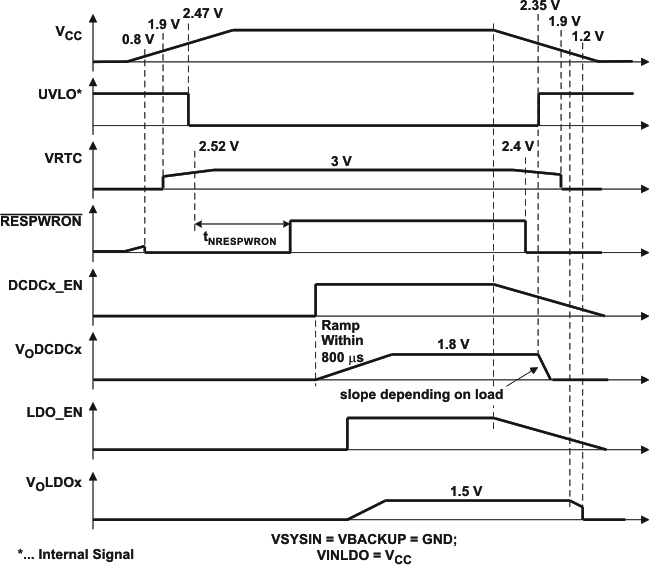 Figure 2. Power-Up and Power-Down Timing
Figure 2. Power-Up and Power-Down Timing
 Figure 3. DVS Timing
Figure 3. DVS Timing
 Figure 4. Serial I/F Timing
Figure 4. Serial I/F Timing
7.12 Typical Characteristics
Table 1. Table of Graphs
| FIGURE | |||
|---|---|---|---|
| η | Efficiency | vs Output current | Figure 5, Figure 6, Figure 7, Figure 8, Figure 9, Figure 10, Figure 11 |
| Line transient response | Figure 12, Figure 14, Figure 14 | ||
| Load transient response | Figure 15, Figure 16, Figure 17 | ||
| VDCDC2 PFM operation | Figure 18 | ||
| VDCDC2 low-ripple PFM operation | Figure 19 | ||
| VDCDC2 PWM operation | Figure 20 | ||
| Startup VDCDC1, VDCDC2 and VDCDC3 | Figure 21 | ||
| Startup LDO1 and LDO2 | Figure 22 | ||
| Line transient response | Figure 23, Figure 24, Figure 25 | ||
| Load transient response | Figure 26, Figure 27, Figure 28 | ||
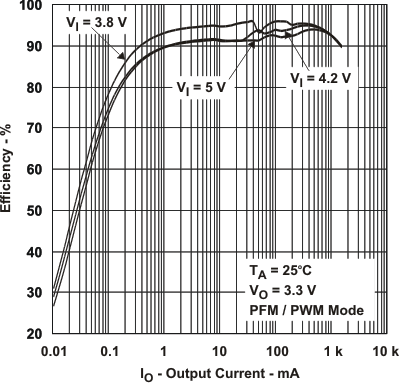 Figure 5. DCDC1: Efficiency vs Output Current
Figure 5. DCDC1: Efficiency vs Output Current
 Figure 7. DCDC2: Efficiency vs Output Current
Figure 7. DCDC2: Efficiency vs Output Current
 Figure 9. DCDC3: Efficiency vs Output Current
Figure 9. DCDC3: Efficiency vs Output Current
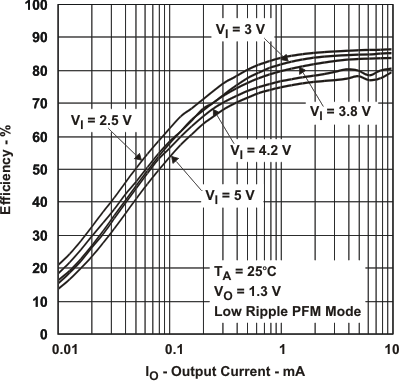 Figure 11. DCDC3: Efficiency vs Output Current
Figure 11. DCDC3: Efficiency vs Output Current
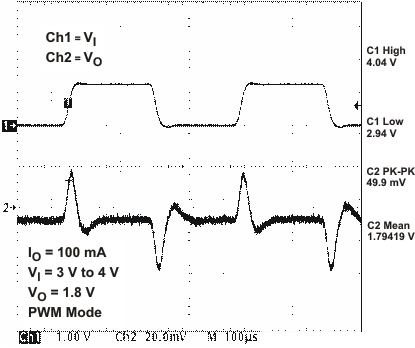 Figure 13. VDCDC2 Line Transient Response
Figure 13. VDCDC2 Line Transient Response
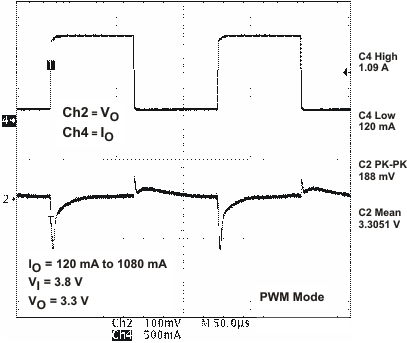 Figure 15. VDCDC1 Load Transient Response
Figure 15. VDCDC1 Load Transient Response
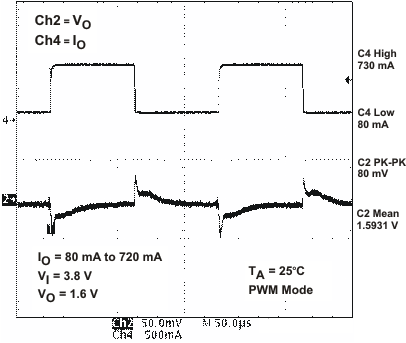 Figure 17. VDCDC3 Load Transient Response
Figure 17. VDCDC3 Load Transient Response
 Figure 19. VDCDC2 Output Voltage Ripple
Figure 19. VDCDC2 Output Voltage Ripple
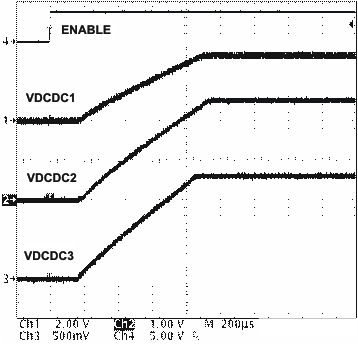 Figure 21. Start-up VDCDC1, VDCDC2, and VDCDC3
Figure 21. Start-up VDCDC1, VDCDC2, and VDCDC3
 Figure 23. LDO1 Line Transient Response
Figure 23. LDO1 Line Transient Response
 Figure 25. VRTC Line Transient Response
Figure 25. VRTC Line Transient Response
 Figure 27. LDO2 Load Transient Response
Figure 27. LDO2 Load Transient Response
 Figure 6. DCDC1: Efficiency vs Output Current
Figure 6. DCDC1: Efficiency vs Output Current
 Figure 8. DCDC2: Efficiency vs Output Current
Figure 8. DCDC2: Efficiency vs Output Current
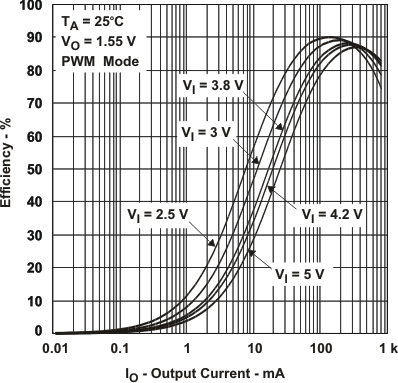 Figure 10. DCDC3: Efficiency vs Output Current
Figure 10. DCDC3: Efficiency vs Output Current
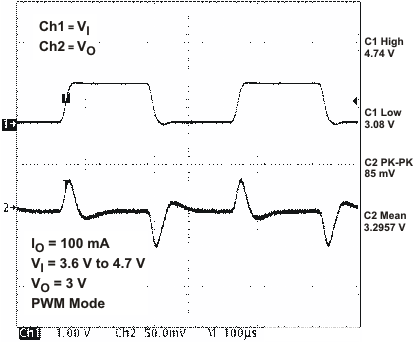
 Figure 14. VDCDC3 Line Transient Response
Figure 14. VDCDC3 Line Transient Response
 Figure 16. VDCDC2 Load Transient Response
Figure 16. VDCDC2 Load Transient Response
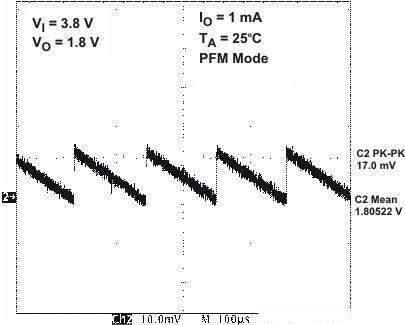
 Figure 20. VDCDC2 Output Voltage Ripple
Figure 20. VDCDC2 Output Voltage Ripple
 Figure 22. Start-up LDO1 and LDO2
Figure 22. Start-up LDO1 and LDO2
 Figure 24. LDO2 Line Transient Response
Figure 24. LDO2 Line Transient Response
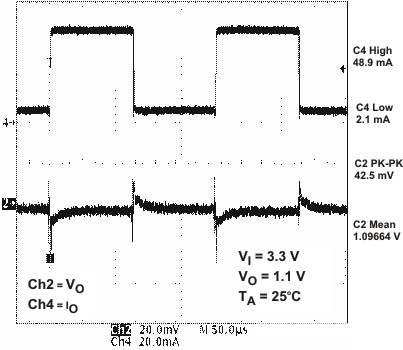 Figure 26. LDO1 Load Transient Response
Figure 26. LDO1 Load Transient Response
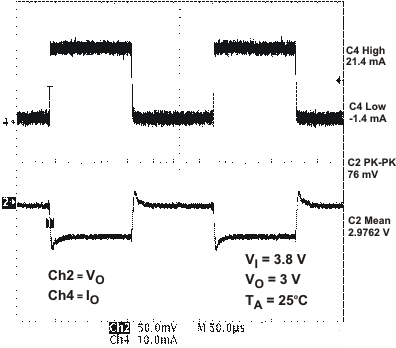 Figure 28. VRTC Load Transient Response
Figure 28. VRTC Load Transient Response